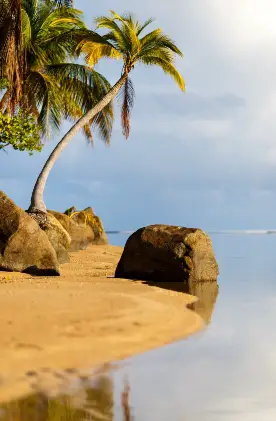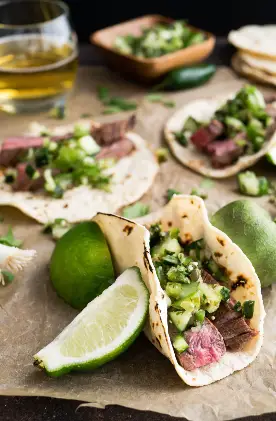Carara National Park, known as Parque Nacional Carara in Spanish, is a beautiful section of rainforest located in the Central Pacific region of Costa Rica. In the indigenous Huetar language, the national park’s name means: “River of Lizards” – a reference to the Rio Tarcoles which is filled with around 2,000 crocodiles. Although, it’s not just crocs that make up the wildlife here. All sorts of animals can be seen such as colorful birds, frogs and sloths.
The top drawcard of Carara National Park is the population of wild scarlet macaws. These large parrots thrive in the forest and river environments of Central America, and boast bright red plumage that covers most of their body – apart from the lower wings which are covered in blue and yellow colors. Seeing scarlet macaws on your trip to Costa Rica is something you will cherish forever, even if you don’t consider yourself a bird-lover.
When you add in the tree species of Carara – including the albizia, ceiba and guanacaste types – you have yourself a natural paradise just waiting to be discovered. Hiking enthusiasts will be in heaven as they traverse stunning trails and soak up the lush vegetation. The opportunities for adventure are endless since the national park is over twice the size of Manuel Antonio – another popular destination in Costa Rica.
It’s also a less visited place, making it easy to immerse yourself in nature without crowds getting in the way. Most travelers venture to Carara from the surf town of Jaco or from the resort town of Los Sueños – both of which are situated only 15 miles away from the park’s entrance. There are plenty of tour companies that can take you into the park on a day trip, where you will be able to balance your beach activities with rainforest experiences.


Best Tours & Things To Do in Carara National Park
Heading into Carara National Park independently is (of course) possible but you miss out on so much by not doing a tour. The naturalist guides at Adventure Tours Costa Rica, for example, are able to expertly lead your group through the rainforest and keep you informed on the flora and fauna throughout. Their Carara Private Rainforest Hike is a 5 hour journey that guarantees wildlife viewing and includes an authentic Costa Rican lunch.
Another option is the Crocodile Mangrove Tour. This popular experience transports you to the Tarcoles River where the largest concentration of crocodiles are to be found in all of Central America. It’s at the mouth of the Tarcoles – where river, swamp and ocean intersect – that the wildlife can be seen in their highest numbers. Not only will you get to watch enormous crocodiles being fed but you will also spot amazing bird-life along the way.
For those who like the sound of those tours, but would like to tick them both off in a day, the Crocodile & Carara Combo might just be the ticket. A full day tour that lasts for 8 hours and incorporates the classic crocodile boat tour with the hikes of Carara. In between these activities, you will stop for a hearty Costa Rican “casado” lunch. Casado means “married man” and the ingredients put together are a marriage made in heaven.
The final Carara National Park tour that ought to be mentioned is the Private Carara Canopy Zipline. With no tourists in sight, it will just be you and your family or friends racing down one zipline to the next – admiring the ocean views and mountainous rainforest as you go. Your guides will ensure your safety during each run and point out the wildlife. The highlight of this tour is soaring over waterfalls – a truly unique experience.





Where to Stay Near Carara National Park
As mentioned, Jaco and Los Sueños are two of the closest destinations to Carara National Park and both will appeal to different types of travelers. Jaco is located 90 minutes from the Costa Rican capital of San José, and is one of the most popular holiday spots for locals and tourists alike. Josefinos regularly visit this seaside town when they crave a break from the city, and foreigners are lured in by its jungle-draped hills and beautiful beaches.
Surfing is Jaco’s main activity. Beginners and experts can find waves to suit their abilities. When the sun sets, the town comes to life with bars blasting live music and parties raging on into the early hours. That being said, this atmosphere might not suit the quiet or family-based traveler. Luckily nearby there is another town which boasts luxury and a relaxed vibe – that of the newly completed resort and marina called Los Sueños.
Los Sueños is home to classy hotel chains, picturesque golf courses and epic ocean views. While Jaco is known for its surf, Los Sueños is known for its sportfishing. The deep sea fishing here is regarded as some of the best in the Americas, so while the guys go out fishing the girls can relax by the pool or go shopping at the village mall. It’s also just an hour away from the airport in San Jose, making it a breeze to reach for international visitors.
Whether you choose Jaco or Los Sueños – be assured that Adventure Tours Costa Rica can help you find the perfect hotel, condo or vacation rental. Their stays span a broad range of options – from secluded villas to beachfront bungalows. Adventure Tours Costa Rica pride themselves on offering the low rates and most exclusive properties. So browse through their Costa Rica accommodation and see what you can find.




How to Get to Carara National Park
Getting to Carara is fairly easy depending on where you are coming from. For starters, you can catch the bus from Jaco for less than $2 USD and the trip takes about 45 minutes. The bus leaves every hour but check in advance to ensure you don’t miss your desired time. Budget travelers will find this to be the best option. If your hotel has a reception, you can ask the staff to see where the nearest bus stop is and which number to take.
The bus takes you directly to the park entrance and if you don’t mind public transport, then it’s both cheap and convenient. Another possibility is to rent a car from Jaco or Los Sueños. This, albeit more expensive mode of transportation, is the most popular way to get around in Costa Rica. With your own vehicle, the driving time to Carara is roughly 30 minutes. This can save you valuable time and give you a few extra minutes to sleep in.
But hands down the best way to reach Carara is on a tour with Adventure Tours Costa Rica. They will pick you up at your hotel and drop you back at the day’s end. Lunch is included on their Carara tours which means you don’t have to worry about finding a place to eat in the middle of your hiking or wildlife experience. Better yet, your chances of spotting wild animals are much higher on a guided tour than by going on your own.
At only $79 USD per person, the Carara Private Rainforest Hike is great value for money when you consider all the expenses that go into a day trip: transport, lunch, park entrance fee, etc. Having a knowledgeable guide with you the entire time will enhance your experience tenfold by allowing you to learn interesting facts about the birds, frogs, monkeys and plants. It’s a fun and educational experience that the whole family can enjoy.
Need to Know Before you Go
Carara is open from 8am to 4pm. It’s recommended to arrive early to beat the heat and crowds, and to get the best chance of spotting wildlife – as many creatures are active before noon. In terms of the time of year, there are two seasons to consider: the dry season from December to April and the rainy season from May to November. The dry season is sunny while the rainy season brings precipitation. You can visit all year round.
Many visitors who go to Carara National Park alone often miss the wildlife, either through bad luck or not knowing where to search. This is why we can’t stress enough the importance of going with a guide. It’s worth every penny. Also, many solo tourists who do get the good fortune of seeing animals don’t know what they are looking at. They take the photo but can’t name the species of bird or frog they have found. And what a shame that is.
Our last piece of advice is around what to pack. The first essential is a device that allows you to spot wildlife easily. Binoculars are a given and should be in everyone’s bags. A camera with a telephoto lens is also great to take shots from afar. It’s not uncommon to see monkeys hiding in treetops or birds flying in the distance. Bug repellent is a must and plenty of water. If you come during the rainy season, pack a poncho too.
























